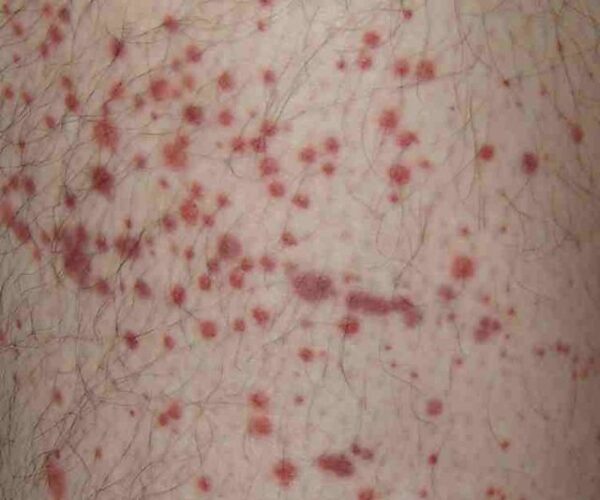- 📖 Geeky Medics OSCE Book
- ⚡ Geeky Medics Bundles
- ✨ 1300+ OSCE Stations
- ✅ OSCE Checklist PDF Booklet
- 🧠 UKMLA AKT Question Bank
- 💊 PSA Question Bank
- 💉 Clinical Skills App
- 🗂️ Flashcard Collections | OSCE, Medicine, Surgery, Anatomy
- 💬 SCA Cases for MRCGP
To be the first to know about our latest videos subscribe to our YouTube channel 🙌
Introduction
A 6-year-old boy is brought to the emergency department by his mother with an acute rash. Work through the case to reach a diagnosis.
UK Medical Licensing Assessment (UKMLA)
This clinical case maps to the following UKMLA presentations:
- Acute rash
History
Presenting complaint
“I noticed this weird rash on my son George this morning.”
History of presenting complaint
When did this rash start?
“This morning, probably 6 hours ago.”
How did the mother first notice the rash?
“I noticed a few small spots when dressing him this morning, but then I saw more red spots on his arms at lunchtime and realised they weren’t blanching.”
Has the rash changed or has it spread?
“I found spots on his chest, arms and legs at home, and I don’t think it’s spread elsewhere. The spots look the same as they did at home.”
Does George have any other symptoms?
“No he seems fine in himself. He had a cold last week.”
Does George have a fever?
“His temperature was 37.9 with his cold last week, but it’s normal now.”
Is George passing urine?
“Yes, twice this morning.”
Does he have a headache or photophobia?
“He had a headache last week with his cold, but said it’s better now.”
Has George been lethargic or difficult to wake?
“No.”
Has he been losing weight?
“I don’t think so.”
Does he seem to bruise easily?
“Not really, he plays a lot with his older brother though.”
Has he had any bleeding?
“No.”
Does he seem particularly tired all the time, or does he have frequent infections?
“No he’s a very active boy. He gets coughs and colds occasionally like his brother.
Are you worried about him?
“He seems fine in himself, but I know that if a rash doesn’t disappear that could be serious, so I brought him straight in as I was scared.”
Important diagnoses to rule out in a child with petechial rash include sepsis (particularly with Neisseria meningitidis), and malignancy (e.g. leukaemia). Think about features of sepsis which may be present (e.g. fever, parental concern, difficult to rouse, altered mental state, reduced urine output).
Children with leukaemia can present with vague symptoms such as fatigue, reduced appetite, weight loss, bone/joint pain, easy bruising/bleeding, and frequent infections.
Other parts of the history
- Past medical history: Admitted with bronchiolitis aged 10 months
- Medications: None, no allergies
- Vaccination history: Up to date
- Birth history: Born at term by normal vaginal delivery, no antenatal or postnatal complications
- Development: No concerns
- Social history: Lives with mother (chemical engineer), father (chef), 8yo brother, dog. No smokers in household. Attends school. Brother also had a cold 2 weeks ago.
- Family history: Nil
A full history is vital in every case. Vaccination history is particularly important to ask for a child with petechial rash, when considering diagnoses such as meningococcal sepsis. Social history needs to be detailed for all paediatric patients, as it may highlight safeguarding concerns.
For more information, see the Geeky Medics guide to paediatric history taking.
Clinical examination
Rash
An image of the patient’s rash is shown below:

The rash has the following features:
- Distribution: Unable to determine from this picture; however, you identify areas of spots on George’s chest, upper right arm, left forearm, and both shins.
- Configuration: Multiple discrete lesions.
- Morphology: Macular, round.
- Size of lesions: Picture not to scale; however, the lesions seen on George range from 1-3mm.
- Colour: Predominantly erythematous; however, some lesions appear purplish.
- Other features: Non-blanching when pressed.
- General examination
- Basic observations (vital signs)
- Neurological examination
Examination findings
General examination:
- George is shy but interacts appropriately.
- Appears a normal colour, is dressed appropriately, and looks clean.
- He is active during the examination.
- He is weighed on admission and is following the 50th centile.
- Temperature 36.8oC
- Heart rate 90bpm
- Respiratory rate 20/min
- Blood pressure 100/60mmHg
- SpO2 98% in air
- Normal
- No signs of meningism
Investigations
Full blood count (FBC)
A lumbar puncture or blood culture could be considered but George is currently apyrexial and well, therefore should not require these at this stage.
Blood results
Some of the results of the patient’s blood tests are shown below:
- Hb 135 g/L
- WCC 9.6 x 109/L
- Platelets 50 x 109/L
Diagnosis
Immune thrombocytopenia (ITP) is a condition which results from the immune destruction of circulating platelets, causing a platelet count <100. To diagnose ITP, there must be an absence of other causes for the thrombocytopenia.
Features which make this the most likely diagnosis are:
- George is clinically well and apyrexial, with no other symptoms.
- He recently had a viral illness.
- There are no red flags present.
- His platelet count is low with a normal haemoglobin and white cell count.
Haemolytic uraemic syndrome (HUS) is a triad of
- Microangiopathic haemolytic anaemia
- Thrombocytopenia
- Acute kidney injury (AKI)
HUS is caused by infection with E.coli 0157, and typically affects children aged 6 months – 5 years. Symptoms include diarrhoea (which usually turns bloody from day three), abdominal pain, fever and vomiting. The child may have a petechial rash on examination, with abdominal tenderness, fever, and hypertension (due to renal involvement).
Bloods will show anaemia (due to haemolysis), acute kidney injury, thrombocytopenia, and raised white cells. Urinalysis should be performed to check for haematuria or proteinuria, and a stool culture should be sent for E.coli 0157.
Management
Observation is the most appropriate management, as George is clinically well with no signs of bleeding and his platelet count is not severely low.
- Avoid contact sports.
- Avoid NSAIDs and aspirin (a child <16 years old should not take aspirin anyway).
- Seek medical attention if George’s rash is spreading rapidly or worsening, if he has any bleeding, if he has blood in his stool or urine, if he has a head injury, if he develops other symptoms such as abdominal pain, if he has a fever or becomes generally unwell.
Editor
Dr Jess Speller
References
- Figure 1. Hektor. Purpura. License: [CC BY-SA]
- National Institute for Health and Care Clinical Excellence. Diagnosis of bacterial meningitis and meningococcal septicaemia in under 16s: recognition, diagnosis and management. NICE guideline CG102. Published in 2010. Available from: [LINK]
- Dr Colin Tidy, Patient. Immune thrombocytopenia. Published in 2020. Available from: [LINK]
- Dr Laurence Knott, Patient. Haemolytic uraemic syndrome. Published in 2022. Available from: [LINK]




